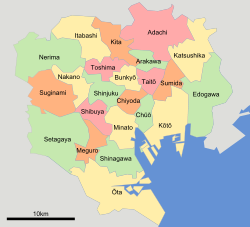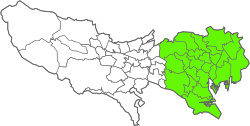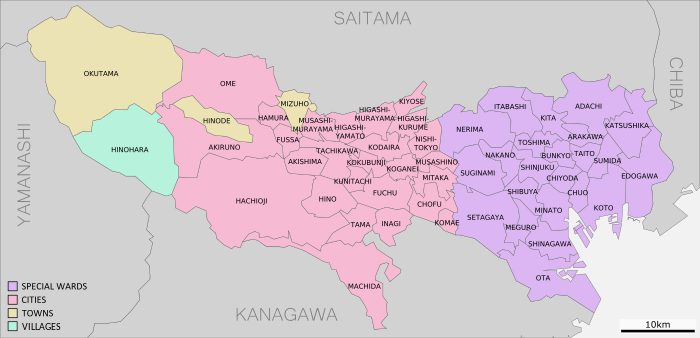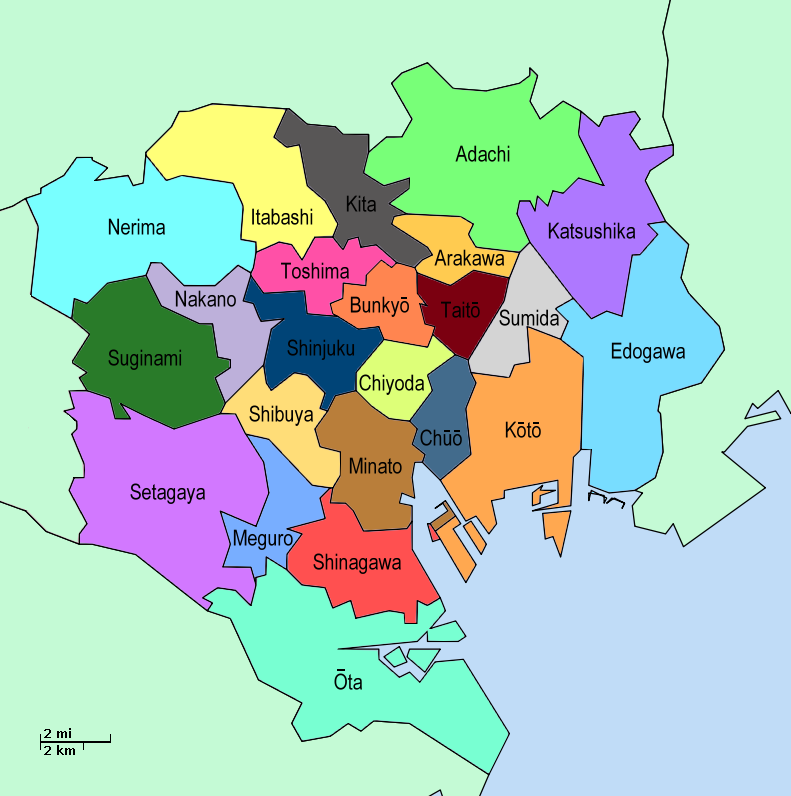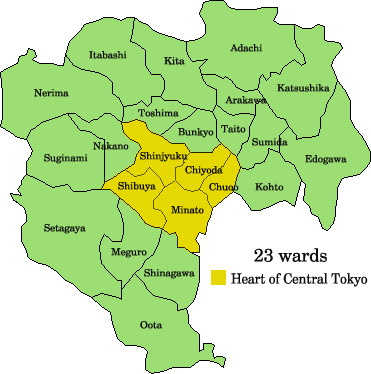Special wards of Tokyo
The 23 wards of Tokyo (东京23区Japanese, Tōkyō nijūsan -ku ) are 23 municipalities in the field of resolution 1943 city of Tokyo. As tokubetsuku (特别 区, literally. " Special " or " special districts ," engl special wards or " cities" ), they have a special status as authorities whose parent management unit is directly Tokyo Prefecture. Emerged the districts in 1947 from the former boroughs of the city of Tokyo. Only since 2000 have the formal status of municipalities, but they still leave some communal task of the Prefecture. This management structure is unique in Japan and exists only in Tokyo; in the prefecture of Osaka are plans to dissolve the cities Osaka and Sakai as Tokyo and to organize the urban areas in special districts of Osaka Prefecture. After Act 2012 adopted such an option is now eight major cities and twin cities and their surrounding communities open: In addition to Osaka Sakai this Sapporo in Hokkaido, Saitama in Saitama Prefecture, Chiba in Chiba Prefecture, Yokohama -Kawasaki in Kanagawa Prefecture, Nagoya in Aichi Prefecture, Kyoto Prefecture Kyoto and Kobe in the Hyōgo Prefecture.
In Japanese, the wards of Tokyo are often referred to only as nijūsanku (23区), which simply " 23 districts " means. For all of the 23 districts are also the names of Tokyo, Tōkyō-to kubu used (东京 都 区 部, such as " area of the districts of Tokyo Prefecture ") and " former city of Tokyo " (旧 东京 市, Tōkyō- shi - kyū ). Officially, the districts call in English today as a city (eg Shinjuku City, Shibuya City ), the prefectural government will continue to use the translation Special Ward.
Management
The individual districts are autonomous and each have its own administration and its own elected mayor (区长, Kucho ). At the same time, however, they also need to work seamlessly together and function as a large urban unit in Tokyo. Thus, certain public facilities - such as water supply, wastewater and firefighters - administered by the prefecture and not from the respective district.
To finance these common public services in 23 districts, the prefecture pulls a few of the taxes that would normally charge a municipality. In addition, transfer payments to districts that can not afford even their management, was made.
History
After the Meiji Restoration and the establishment of the Edo / Tokyo Prefecture later the city of Tokyo was divided in 1871 into several dozen " large and small districts ." 1878 emerged with the introduction of counties and municipalities belonging from 15 districts with an appointed county mayor, from 1880, selected district assemblies. These districts were 1889 with the establishment of the city of Tokyo whose districts. 1932 many suburbs of Tokyo were incorporated, with 20 new districts created. By 1943, the districts of Tokyo were therefore no different from the municipalities of Osaka and Kyoto.
In the Pacific War, the government eliminated the 1943 Local Government (Council and Mayor ) of the city of Tokyo, by breaking down the city administration and the districts now directly ordered by the Interior Ministry and the prefectural government appointed by the central government governor was assumed. The - in addition to the specific Tern Tokyo by the other inhabitants of the Prefecture - Prefecture Parliament remained as elected institution, but possessed the empire only a limited effect, and could be dissolved at any time by the Home Secretary.
During the occupation, the prefectural government in 1947 was democratized, the city of Tokyo but not restored. Instead, the districts were given an organizational form as "special districts " at the local level, but were not subsequently recognized as communities under the Constitution of 1947. The number of districts was reduced simultaneously by mergers from 35 to 23. The right to elect their own mayor directly granted to the districts at the beginning of the occupation after occupation administration arrangements of the national parliament, but in 1952 removed. Thereafter, the district mayors were appointed on the proposal of the district parliaments by the Governor. The Supreme Court upheld in 1963 in a decision that the special districts were no authorities, and consequently had no right to directly elected mayors in the sense of the Law on Local Self-Government. It was not until 1975 ( adopted 1974) was again granted them this right by the national parliament.
In a further reform in 2000 (adopted 1998) determined the national parliament the districts to local authorities. Since then, the districts designate English official cities (city ) instead of ward (district), although the Japanese term tokubetsuku ("special district " ) is unchanged. At the same time they took back some public functions of the prefecture, such as waste disposal. The prefecture but still retains some local taxes, and some municipal tasks.
Geography
The districts differ greatly in size (from 10 to 60 square kilometers ) and population ( 51000-890000 ). Setagaya has it most of the population while the neighboring district Ōta has the largest area.
The total population of the 23 districts is 9,071,577 inhabitants (as of February 1, 2014), and thus about two-thirds of the population of Tokyo prefecture, and about a quarter of the population of the metropolitan area of Tokyo ( see Tokyo). The 23 districts together have a population density of 14,585 inhabitants per km ².

